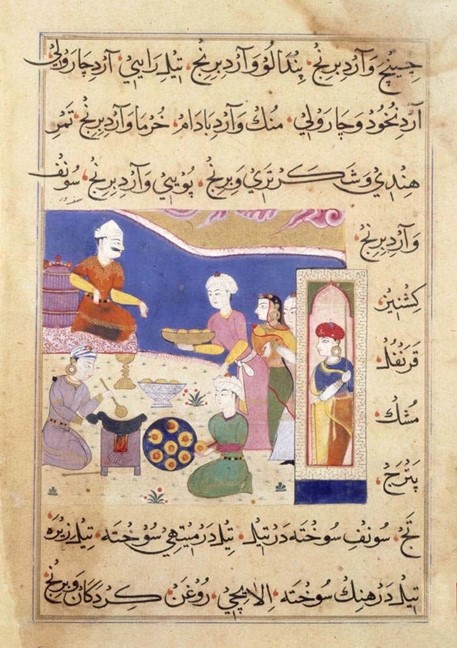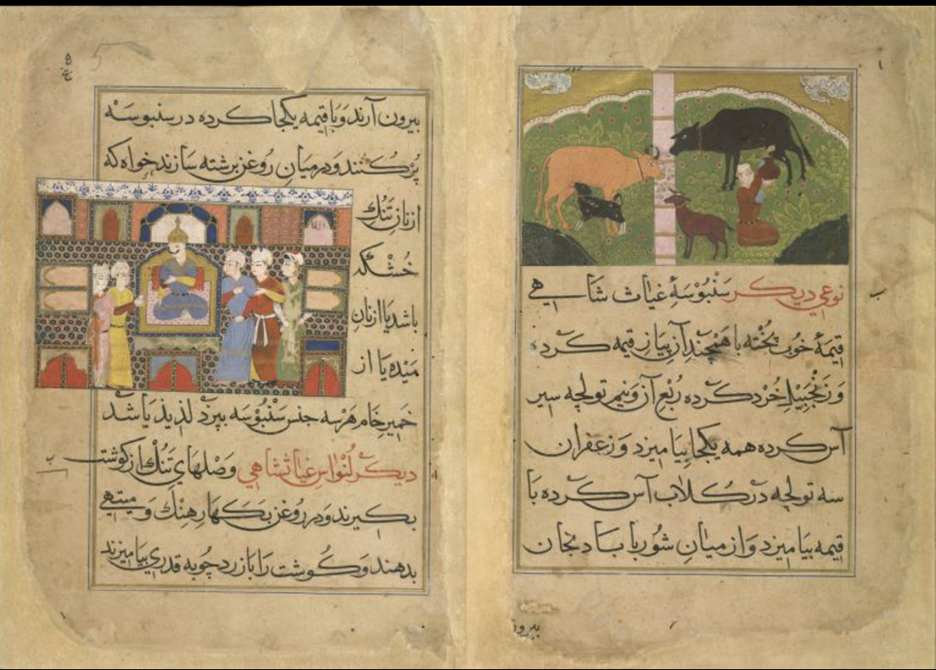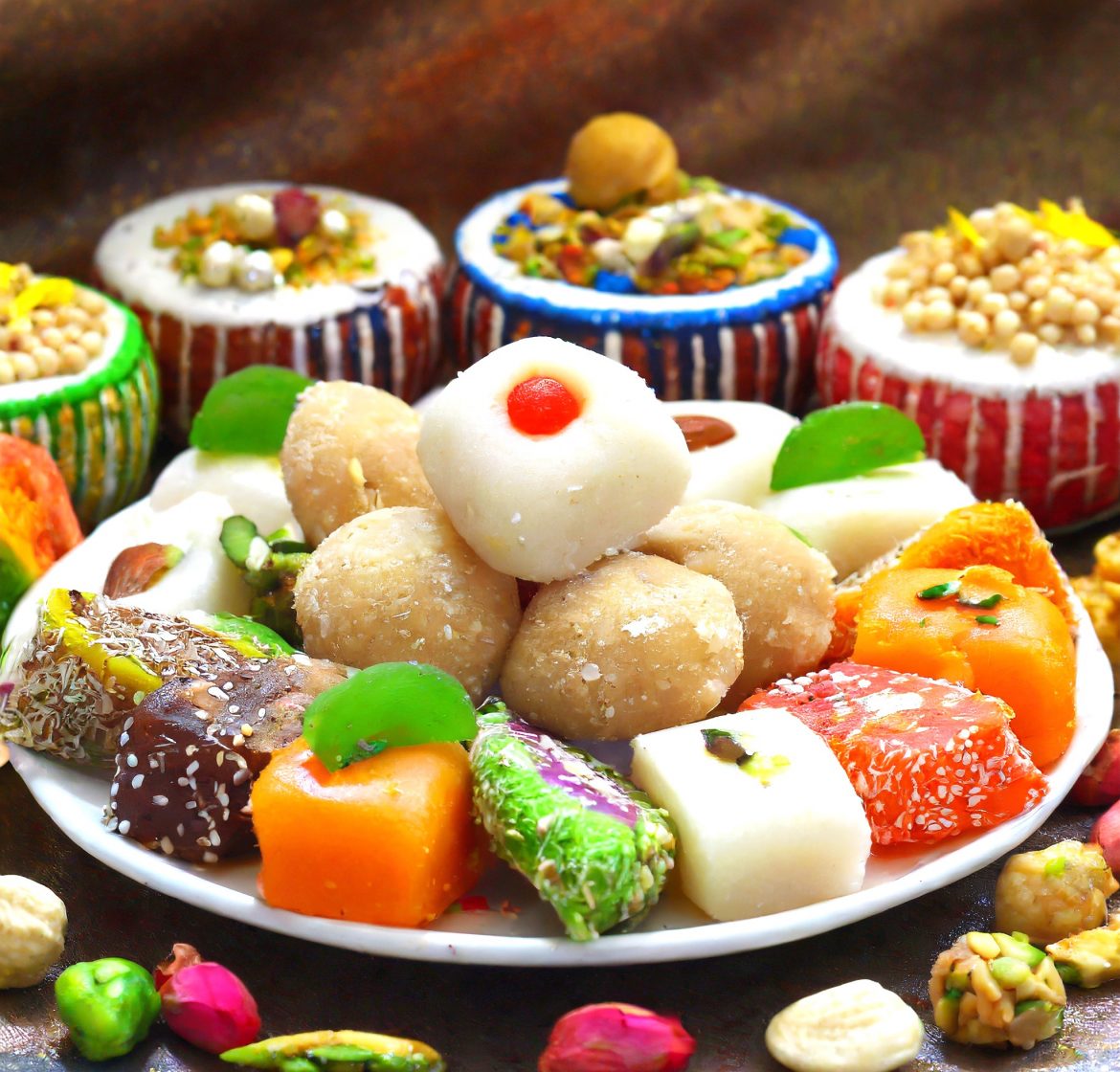Core elements of Mughal cuisine
Mughal cuisine’s core lies in a delightful fusion of fragrant spices, dried fruits, and aromatic herbs. Essential spices such as cardamom, saffron, cinnamon, cloves, and nutmeg infuse Mughal dishes with their distinctive and captivating flavors.
Mughal cuisine, also known as Mughlai cuisine, originated in northern India, encompassing cities such as Lahore, Delhi, and Hyderabad during the Mughal Empire. It amalgamates Turkish, Persian, Central Asian, and Indian cooking styles to craft flavorful dishes that have evolved over time.
Numerous dishes and foods in Pakistani and Indian cuisines share names similar to those from Tajikistan, Uzbekistan, and Kazakhstan. While there may be slight differences in pronunciation, the names still bear resemblances. For instance, similarities can be observed in names like Chorba, Dastarkhān, Halva, Manti, Tandoor, Pilao, and Nan.
During the Mughal era, various emperors contributed to the culinary landscape of their reigns. Emperor Akbar’s Ain-i-Akbari, while not a dedicated cookbook, provides insight into the food and beverages consumed during his rule. Emperor Jahangir’s reign saw the commissioning of the Nimmatnama-i-Nasiruddin-Shahi by Ghiyath Shah of Malwa, showcasing a blend of Central Asian and Indian dishes such as samosas, khichri, and kebabs. Emperor Shah Jahan’s court was known for its culinary extravagance, with the Nuskha-i-Shahjahani detailing a wide array of dishes including breads, meats, and sweets. Similarly, Emperor Aurangzeb’s era possibly saw the creation of the Ḵẖulāṣat-i Mākūlāt u Mashrūbāt, a cookbook thought to contain recipes from his time.
The Essence of Mughal Savory Classics
- Mughal cuisine is well-known for its rich and creamy sauces, which are used in popular dishes such as the smooth “Korma” and the tempting “Pasanda.” The Mughals introduced the “Dum Pukht” cooking method, in which meat and vegetables are slow-cooked in their own juices, resulting in a tender and flavorful outcome.
- You can enjoy succulent kebabs, including the famous “Seekh Kebab“ and the delightful “Shami Kebab.” You can also try aromatic rice preparations such as Biryani and Pulao, which are layered with spices and tender meat, defining Mughal feasts. The timeless appeal of “Mughlai Biryani” is a testament to the enduring legacy of Mughal culinary mastery.
- Vegetarian options include Kichri, a lentil and rice dish that is a variation of Pilaf. It is often consumed when one’s stomach is upset or during sickness, as it is considered a mild and easily digestible food that is not too heavy on the stomach.
Begin by sautéing fried garlic in ghee until aromatic, then add onion rings, cinnamon, and other spices, and fry them once again. Next, introduce cumin into the mixture and remove the entire blend from the heat. Proceed by frying Mungbean pulses (lentil) (dāl mūng) in the same ghee until lightly golden, then drain the excess ghee. Combine rice with the fried pulses, ensuring thorough mixing. Incorporate the previously prepared spice mixture into this rice and pulse blend, along with hot water and ginger. Finally, add ghee, seal the dish, and cook it slowly until fully done.
A Khichri Recipe from “The Nimmatnama-i-Nasiruddin-Shahi”-“Book of Delights” from 1495 and 1505
- Another notable dish is Harisa, a cooked dish crafted from a blend of grains, typically half-ground wheat and barley, and meat, commonly lamb and, more recently, sometimes beef. It bears a striking resemblance to ḥalim.

Mughal Era Samosa Recipe
Mughal Desserts that Define Opulence
- The Mughals naturally fonded the sweeter side of life, evident in their delightful desserts. The traditional “Sheer Khurma,” a luscious milk and vermicelli pudding adorned with nuts and dried fruits, holds a special place in Mughal cuisine, particularly during festive occasions like Eid. Furthermore, the irresistible allure of “Gulab Jamun” and “Jalebi” continues to captivate dessert enthusiasts across the Indian subcontinent, with their origins tracing back to the Mughal era.
- Another distinctive sweet treat is White Pumpkin soaked in sugar syrup, known as Petha. This delicacy is enjoyed on its own as a dessert or incorporated into other desserts as condiments, such as sweet rice (Mutanjan/Zarda) or burfi. The origins of Petha are believed to date back to Shah Jahan, around 400 years ago.
- Petha is not only enjoyed on its own as a standalone dessert, providing a delightful combination of sweetness and the natural, mild flavor of pumpkin, but it is also commonly employed in various culinary creations to enhance the taste and texture of different dishes. It is a versatile ingredient that adds a unique touch to various delicacies, including Mutanjan/Zarda, Burfi, and other sweets and desserts. Its subtle sweetness and distinctive texture make it a sought-after addition, contributing to the richness and complexity of these culinary delights.
- “Gulab Jamun,” or Rose Berry in English, is a Central Asian dish that made its way to medieval India. It originated from a fritter that Central Asian Turkic people brought to India. Similar dishes can be found in other regions, such as the Arabic “Luqmat al qadi,” Turkish “Tulumba,” and Persian “Bamieh.” Gulab Jamun consists of soft, deep-fried dumplings made from milk solids, such as khoya (reduced milk) or milk powder. These dumplings are soaked in a sugar syrup flavored with rose water or cardamom, providing a sweet and aromatic indulgence.
- The Rasgulla is a ball filled with syrup, believed to have been brought to Bengal by the Portuguese in the sixteenth century. Bengali homemakers then adapted and improvised the recipe. Rasgulla is a spongy, syrup-soaked cheese dumpling that offers a delightful combination of sweetness and texture.
- Chum Chum or Chomchom, a similar dish popular in Bengal, is a colorful and smaller version of Rasgulla.
- The word “Jalebi” is derived from the Arabic word “zulabiya” or the Persian “zolbiya.” In Nepal, it is known as “Jerry,” a term derived from “Jangiri” and the Mughal Emperor Jahangir. Jalebi is made by deep-frying fermented flour batter and soaking it in sugar syrup, resulting in a sweet and tangy treat.
- Amarti/Amrati,” also called Jhangiri, is similar to Jalebi but is made with black gram or mungo flour. It is deep-fried in ghee and soaked in saffron and sugar syrup. Amitti is a popular Iftar item in Bangladesh.
- “Makhan Bada” or “Balloshahi” is a flaky, deep-fried donut dipped in sugar syrup. It is similar to Baklava.
- “Barfi,” a Persian word meaning snow, is made of condensed milk and sugar. In its frozen form, it is called “kulfi.” Kulfi is typically served in small, conical molds or clay pots, offering a delightful way to cool down on a hot day. While “barfi” may sound similar to the Persian word for “snow,” it refers to a fudge-like sweet made from condensed milk, sugar, and other flavorings in the context of Indian sweets.
- Though there might be linguistic and historical overlaps in the names of these sweets, they are two separate and distinct desserts in Indian cuisine, each with its own unique characteristics and flavors. “Barfi” is more commonly associated with the fudge-like sweet, while “kulfi” refers to the frozen dessert. Both “barfi” and “kulfi” showcase the creativity and diversity of Indian sweets, offering a wide range of flavors and textures catering to different preferences and occasions.
- “Faloodah” is a cold dessert made with Vermachili, kulfi, and milk with rose water, sweet basil seeds, and a consistency similar to faloodah.
- “Laddu” is believed to be an indigenous Indian dish served on many Hindu festivals in India long before the Mughals came to the subcontinent. Laddus are made with chickpea flour or mung bean flour balls soaked in sugar syrup. A similar snack is called “Nugdi,” made with fried chickpea flour dipped in sugar, but it is eaten as a snack and has a finger-like stick shape rather than a round shape.
According to folklore, Shah Jahan instructed his chefs to create something as pure and white as the Taj Mahal, leading to the creation of Petha.
Halva : From Persia to Mughal India
“Halva” or “Halwa” is an Arabic word that means sweet. It is an ancient dessert found from ancient Greece to the Middle Eastern, Central Asian, and Indian subcontinent. The name is used for a wide variety of recipes, generally referring to a thick paste made from ingredients such as flour, butter, liquid oil, saffron, rosewater, milk, cocoa powder, and sugar.
In the Indian context, there are various types of Halva, each with its unique ingredients and flavors. Examples include:
- Sooji Halva (Semolina Halva): Made from semolina, ghee, and sugar.
- Chana Halva (Chickpea Flour Halva): Prepared using chickpea flour, ghee, and sugar.
- Gajar Halva-Cooking shredded carrots in milk, ghee, and sugar until milk gets thickened and condensed.
- Petha Halva (Shredded Pumpkin and Condensed Milk Halva): Combining shredded pumpkin with condensed milk.
- “Habshi Halwa” is a rich milk halva variety, typically made by combining milk, sugar, sprouted wheat, ghee, aromatic spices, and nuts. It is considered a winter treat and is called “Habshi Halwa” due to its dark brown color, similar to the complexion of the Arabic Habshi people. It is also believed to be part of Mughal cuisine, adding to the region’s diverse and flavorful array of halva varieties.
Similar to Halva, there are puddings with milk added to them.
- Kheer and Firni: Kheer is a rice pudding made with basmati rice, milk, nuts, and sugar, and it can be scented with cardamom powder, saffron, or rose water.
- Firni or Phirni is also a rice pudding, but firni is made from ground rice, while kheer uses whole rice.
- Gajrella: A rice and carrot pudding similar to kheer. The only difference is the addition of carrots.
- Shahi Tukray: It is believed to have been introduced by Europeans in India during the sixteenth century. Bread is soaked in hot, sugary milk blended with spices such as cardamom and saffron. It is a special dish served during events such as Eid and Ramadan.
- Sheer Khurma: A festive vermicelli pudding prepared by Muslims on Eid ul-Fitr and Eid al-Adha in India, Pakistan, Afghanistan, and parts of Central Asia. “Sheer” means milk, and “Khurma” means dates in Persian. It is made with vermicelli, milk, dates, saffron, and nuts, cooked until the milk thickens and sweetens. Sheer Khurma is served both hot and cold and is a traditional Eid dish in India and Pakistan.

Another Recipe of Mughal Era
Moraba: Persian Preserves in Mughal Kitchens
Moraba, an Arabic cuisine introduced to India by the Mughals, refers to preserved fruits in sugar syrup. It has become a familiar and beloved item in households across India and Pakistan. Moraba can be made with various fruits, including apples, unripe mango, carrots, and rose petals.
A specific type of Moraba is Plum Moraba, commonly known as ‘Aloo Bukhara.’ The term ‘Aloo’ is derived from the Persian word for plum, and ‘Bukhara’ indicates its source from the Balkan region, primarily Uzbekistan. The sweet and tangy flavor of Aloo Bukhara Moraba, along with its preserved nature, makes it a popular choice in the culinary traditions of the Indian subcontinent.
Sharbat: A Refreshing Mughal Beverage Legacy
Sharbat” is an Arabic word for sugary drinks made with water, fruit juice, and flowers. It is a refreshing beverage enjoyed during the summer or hot months and is commonly consumed during Ramadan to break the fast. The term “sharab,” derived from “sharbat,” is used for alcoholic drinks.
The word “sharbat” has influenced other languages, entering Italian as “sorbetto,” which then became “sorbet” in French. Turkey played a role in introducing sharbat to Europe.
Traditionally, sherbet was made with cane juice but can also be made with sugar and honey. It gained popularity in the Indian subcontinent, especially after Babur, who sought frequent loads of ice from the Himalayas to create a cool, refreshing drink.
Various types of sherbets include:
- Tamarind Sherbet: Originating from Turkey.
- Almond Sherbet (Originated in Persia)
- Sandalwood Sharbat
- Phalsa Berries Sherbat
- Rose Sherbet
- Lassi: A yogurt drink.
- Kanji is a probiotic drink made by fermenting black carrot juice. It has a slight alcoholic content, ranging from 1-3%, depending on yeast activity and carrot sugar content.
- Sekanjabin: Similar to the Iranian drink, but made with lemon and mint instead of vinegar. It is also known as lemon water or lemon pani.
This sherbet recipe involves finely chopping coconut and steeping it in sweetened water. After straining the coconut milk, the syrup and mangoes can be added if desired. This mixture is then enjoyed with cooked rice or maize, infused with fresh ginger, onions, lime juice, cardamoms, cloves, pepper, turmeric, and fenugreek, and flavored with asafoetida.
A Khichri Recipe from “The Nimmatnama-i-Nasiruddin-Shahi”-“Book of Delights” from 1495 and 1505
The influence of Mughal cuisine on Indian culinary traditions cannot be overstated. Countless dishes and cooking techniques introduced during the Mughal era have been adapted and celebrated in various regions, giving rise to diverse flavors across the subcontinent.
Today, Mughal cuisine remains an esteemed treasure within the culinary heritage of India and neighboring countries. Its opulent flavors and intricate preparations continue to delight and entice gastronomes worldwide, offering a tantalizing glimpse into the extraordinary culinary legacy of the Mughal Empire.
If you want to read more about this, check out the British Library’s blog post titled ‘Nasir Shah’s ‘Book of Delights” on the Asian and African Studies Blog, published on November 25, 2016, available at blogs.bl.uk/asian-and-african/2016/11/nasir-shahs-book-of-delights.html.
